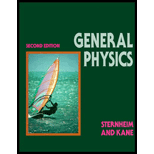
Concept explainers
(a)
The energy of lowest level of muonic atom.
(a)
Answer to Problem 39E
The energy of lowest energy level is
Explanation of Solution
Write the expression for energy of atom.
Here,
Conclusion:
Substitute
Thus, the energy of lowest energy level is
(b)
The radius of lowest energy orbit.
(b)
Answer to Problem 39E
The radius of lowest orbit is
Explanation of Solution
Write the expression for radius.
Here,
Conclusion:
Substitute
Thus, the radius of lowest orbit is
(c)
The ratio of orbital radius to that of sulfur.
(c)
Answer to Problem 39E
The ratio of orbital radius to that of sulfur is
Explanation of Solution
Write the expression for ratio.
Here,
Conclusion:
Substitute
Thus, the ratio of orbital radius to that of sulfur is
Want to see more full solutions like this?
Chapter 27 Solutions
General Physics, 2nd Edition
- At what velocity does a proton have a 6.0-fm wavelength (about the size of a nucleus)? Give your answer in units of c.arrow_forwardIn atoms there is a finite, though very small, probability that, at some instant, an orbital electron will actually be found inside the nucleus. In fact, some unstable nuclei use this occasional appearance of the electron to decay by electron capture. Assuming that the proton itself is a sphere of radius 1.1 * 10-15 m and that the wave function of the hydrogen atom’s electron holds all the way to the proton’s center, use the ground-state wave function to calculate the probability that the hydrogen atom’s electron is inside its nucleus.arrow_forwardGold has a work function, Φ, of 5.47 ev. If a sample of gold is bombarded with 175 nm photons, what will be the velocity (in m/s) of the photo-ejected electrons? (1 eV = 1.60 × 10⁻¹⁹ J, the mass of an electron is 9.109 x 10⁻³¹ kg, and Planck's constant is 6.626 x 10⁻³⁴ Js.)arrow_forward
- What wavelength of light, in nvm, is needed to ionize a hydrogen atom (ie, to remove the electron from it)arrow_forwardAssume that a gold nucleus has radius of the 6.98 fm and the α-Particle has a radius of 1.8fm, what energy must an incident α-Particle have a just touch the gold nucleus?arrow_forwardFind the most probable radius of a 5p electron.arrow_forward
- The isotope of Nickel, 66Ni decays by β emission, has a half-life of 2.3 days. and the β particles have an average energy of 65 keV. A source consisting of this isotope has an initial number of atoms N0 = 5 x 1020 atoms. What is the power per unit area initially deposited by this source in a small target placed at 1m distance from the source?arrow_forwardAn electron and a positron undergo pair annihilation . If they had approximately zero kinetic energy before the annihilation, what is the wavelength of each g produced by the annihilation?arrow_forwardOne proton is accelerated through a potential difference of 106 volts and another is accelerated through a potential energy of 1010 volts. For each proton, find the total energy, the momentum (actually find pc in MeV), and the wavelength.arrow_forward
- A particle with spin quantum number (s) of 1/2 is in a magnetic field with a strength of 0.02 Tesla. Calculate the energy difference between the two possible spin states of the particle in joules. The gyromagnetic ratio for the particle is 1.76 x 10^11 rad/T·s.arrow_forwardIt is possible that a muon be captured by a proton to form a muonic atom. A muon is identic to an electron, except when your mass, which is m = 105.7 MeV/c^2. What ia the smallest wave length for a Lyman series for this atom? Give your answer in pm.arrow_forwardAt what speed must an electron travel to have a wavelength of 13.6 pm ?arrow_forward
 Principles of Physics: A Calculus-Based TextPhysicsISBN:9781133104261Author:Raymond A. Serway, John W. JewettPublisher:Cengage Learning
Principles of Physics: A Calculus-Based TextPhysicsISBN:9781133104261Author:Raymond A. Serway, John W. JewettPublisher:Cengage Learning Modern PhysicsPhysicsISBN:9781111794378Author:Raymond A. Serway, Clement J. Moses, Curt A. MoyerPublisher:Cengage Learning
Modern PhysicsPhysicsISBN:9781111794378Author:Raymond A. Serway, Clement J. Moses, Curt A. MoyerPublisher:Cengage Learning Physics for Scientists and Engineers with Modern ...PhysicsISBN:9781337553292Author:Raymond A. Serway, John W. JewettPublisher:Cengage Learning
Physics for Scientists and Engineers with Modern ...PhysicsISBN:9781337553292Author:Raymond A. Serway, John W. JewettPublisher:Cengage Learning University Physics Volume 3PhysicsISBN:9781938168185Author:William Moebs, Jeff SannyPublisher:OpenStax
University Physics Volume 3PhysicsISBN:9781938168185Author:William Moebs, Jeff SannyPublisher:OpenStax



